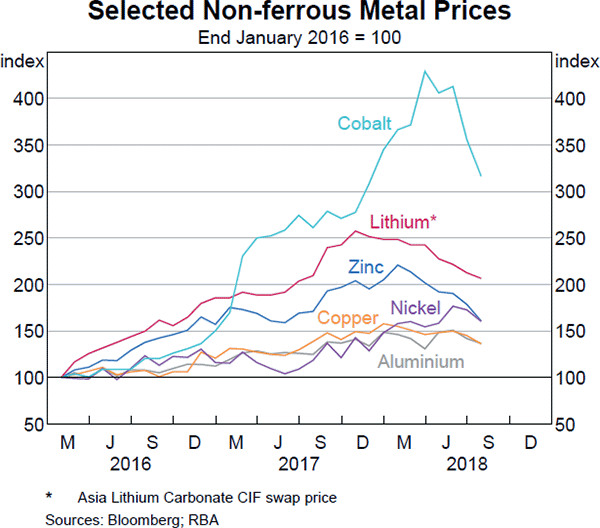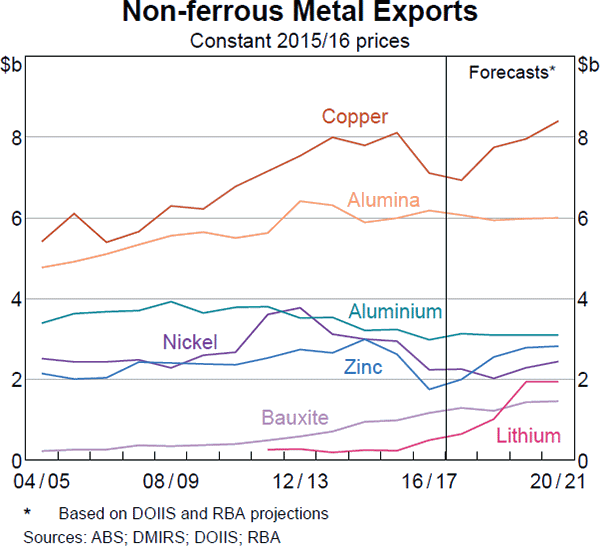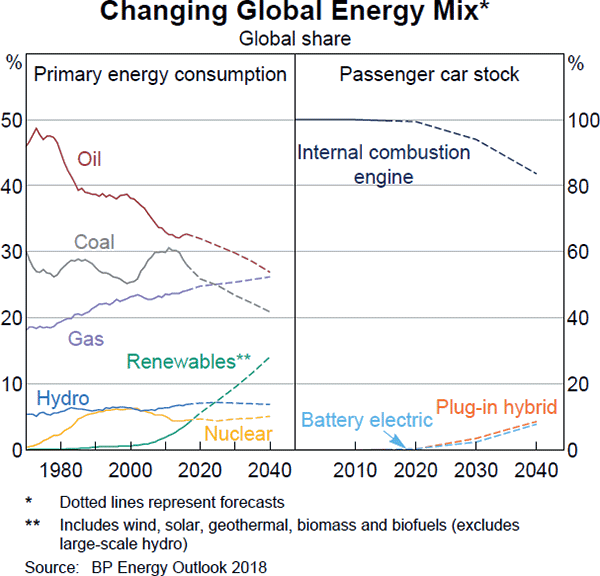Statement on Monetary Policy – August 2018 Box C: Outlook for Non-ferrous Metal Exports
Australia has large reserves of a number of resource commodities other than iron ore and coal, its two largest resource exports. These include copper, bauxite (the ore from which aluminium is produced), zinc, nickel, lithium and cobalt.
Stronger global demand for these commodities, stemming from both cyclical and structural factors, has contributed to significant price increases since 2016 (Graph C1). The pick-up in global GDP growth over this period has resulted in a broad increase in demand for commodities used in industrial production and construction, such as copper, zinc, nickel and aluminium. In addition, the outlook for the global uptake of electric vehicles and renewable energy generation has improved due to government policies and improved cost competitiveness. This in turn has increased the demand for copper, lighter-weight metals and commodities that are used in rechargeable batteries:
- Rechargeable lithium-ion batteries used in electric vehicles (and other applications) contain materials derived from a range of commodities, including lithium, nickel, cobalt, manganese, graphite and rare earths.
- To help offset the additional weight of a battery, the body of an electric vehicle is often manufactured with a higher share of lighter-weight metals such as aluminium and copper compared with a conventional vehicle.
- Renewable energy generation (wind, solar and hydro) uses copper more intensively than coal- or gas-fired generators, partly because of the need for larger earthing systems and longer transmission lines to connect to grids.
- Renewable generation is also increasingly associated with battery storage systems, including rechargeable batteries similar to those used in electric vehicles.

Australia is well placed to meet some of the increase in global demand for these commodities. Around 20–25 per cent of known global reserves for bauxite, lithium, nickel and zinc are located in Australia, and around 12 per cent for copper. Australia was one of the largest five global producers for each of these commodities in 2016.[1] Mineral exploration and mining activity for these commodities has increased over the past two years, after several years of curtailed production and mine closures both in Australia and overseas; stronger commodity prices have supported the confidence and the ability of exploration and junior mining companies to secure financing.
As a result, Australian export volumes for these commodities are expected to increase over the next few years, as new projects commence production, existing mines are expanded, and mines that had been placed in care and maintenance are restarted (Graph C2).[2] Exports of copper and lithium are likely to drive the bulk of this growth; lithium exports are expected to triple over the next few years. Exports of bauxite, zinc and nickel are also likely to contribute to resource export growth, but to a lesser extent.[3]

In aggregate, copper, aluminium and its ores, zinc, nickel and lithium account for a small share of Australia's exports. In 2017 they comprised around 7 per cent of total export values and 13 per cent of resource export values, which was a similar share to liquefied natural gas (LNG).[4] However, this was much smaller than the share of coal and iron ore, which comprised around 30 per cent of total export values and 60 per cent of resource export values in 2017.
Despite the positive outlook for export volumes of these commodities over the next few years, their share of total exports is expected to remain around the same as present. In the period to 2020/21, their combined contribution to total export growth is likely to average around 1/3 percentage point a year; this compares with a forecast average contribution of around 1 percentage point a year from LNG over the same period. Similarly, developments in export prices for non-ferrous metal exports are not expected to materially affect Australia's terms of trade. Instead, iron ore, coal and LNG will remain the most important for overall export prices, because they are still expected to comprise around 40 per cent of Australia's export values in coming years.
Looking beyond 2020, global renewable energy generation and sales of electric vehicles are expected to continue growing strongly as they become more cost competitive. For example, BP expects that, by 2040, renewable energy will account for almost 15 per cent of global energy needs (up from around 5 per cent now), and that there will be more than 300 million electric vehicles on the road (16 per cent of the global car stock; Graph C3).[5] All else being equal, this should continue to support demand for Australia's non-ferrous metal exports.

Alongside prospects for rapid growth in renewable energy production in coming decades, gas may also meet a growing share of global energy needs over this period. This is partly because government policy measures are favouring lower-emission fuels and low-cost gas supplies are expanding. While increased global gas demand could support further growth in Australia's LNG exports, this will depend on Australian LNG's price competitiveness and whether global demand is met from pipeline or LNG sources.[6]
Footnotes
Source: Geoscience Australia. [1]
See DOIIS (Department of Industry, Innovation and Science) Resources and Energy Quarterly – June 2018. [2]
In addition to bauxite, Australia exports alumina and aluminium, but because no additional refining and smelting production capacity is expected for these in the next few years, it is not expected that they will add materially to export volumes over this period. [3]
As a share of resource export values in 2017: copper and alumina each comprised around 4 per cent; zinc, aluminium and nickel each comprised a little under 2 per cent; bauxite and lithium comprised around ½ per cent each; and cobalt comprised less than ¼ per cent. [4]
Based on the Evolving Transition (baseline) scenario in the BP Energy Outlook 2018. Electric vehicles include plug-in hybrid and battery electric vehicles. [5]
See Heath A (2016) ‘The Future of Energy Demand and Implications for Australia’, Address to CEDA's NSW Energy Series: Future Energy Projects, Sydney, 21 June. [6]